

Transmission of a 2009 H1N1 Pandemic Influenza Virus Occurs before Fever Is Detected, in the Ferret Model. Abstract During the early phase of the 2009 influenza pandemic, attempts were made to contain the spread of the virus.

Success of reactive control measures may be compromised if the proportion of transmission that occurs before overt clinical symptoms develop is high. In this study we investigated the timing of transmission of an early prototypic strain of pandemic H1N1 2009 influenza virus in the ferret model. Ferrets are the only animal model in which this can be assessed because they display typical influenza-like clinical signs including fever and sneezing after infection. We assessed transmission from infected animals to sentinels that were placed either in direct contact or in adjacent cages, the latter reflecting the respiratory droplet (RD) transmission route. Citation: Roberts KL, Shelton H, Stilwell P, Barclay WS (2012) Transmission of a 2009 H1N1 Pandemic Influenza Virus Occurs before Fever Is Detected, in the Ferret Model. Editor: Benjamin J. Copyright: © Roberts et al. Influenza in Ferrets: Signs, Diagnosis, Treatment, and Prevention. PLOS Pathogens: Influenza Transmission in the Mother-Infant Dyad Leads to Severe Disease, Mammary Gland Infection, and Pathogenesis by Regulating Host Responses.
Abstract Seasonal influenza viruses are typically restricted to the human upper respiratory tract whereas influenza viruses with greater pathogenic potential often also target extra-pulmonary organs.
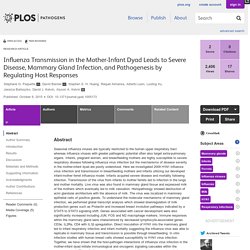
Infants, pregnant women, and breastfeeding mothers are highly susceptible to severe respiratory disease following influenza virus infection but the mechanisms of disease severity in the mother-infant dyad are poorly understood. Here we investigated 2009 H1N1 influenza virus infection and transmission in breastfeeding mothers and infants utilizing our developed infant-mother ferret influenza model. Infants acquired severe disease and mortality following infection. WHO reference laboratories for diagnosis of influenza A/H5 infection. Terms of reference for national influenza centres. Whocccoretor2006. Alternative reassortment events leading to transmissible H9N1 influenza viruses in the ferret model. The ferret as a model organism to study influenza A virus infection. Ferrets and the Challenges of H5N1 Vaccine Formulation.
Alan W.
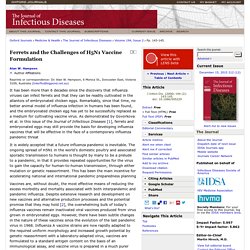
Hampson + Author Affiliations Reprints or correspondence: Dr. Alan W. Hampson, 6 Monica St., Doncaster East, Victoria 3109, Australia (Interflu@bigpond.net.au) Influenza virus transmission. Influenza virus may be transmitted among humans in three ways: (1) by direct contact with infected individuals; (2) by contact with contaminated objects (called fomites, such as toys, doorknobs); and (3) by inhalation of virus-laden aerosols.
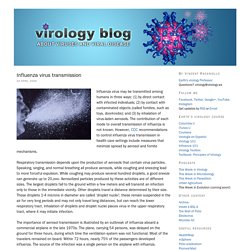
The contribution of each mode to overall transmission of influenza is not known. However, CDC recommendations to control influenza virus transmission in health care settings include measures that minimize spread by aerosol and fomite mechanisms. Respiratory transmission depends upon the production of aerosols that contain virus particles. Speaking, singing, and normal breathing all produce aerosols, while coughing and sneezing lead to more forceful expulsion. While coughing may produce several hundred droplets, a good sneeze can generate up to 20,ooo. [Spanish flu in Norway 1918-19].
The Dead Zone. Seven bodies buried in the Artic tundra might solve the riddle of the worst flu pandemic in history — and might help us prevent it from happening again.
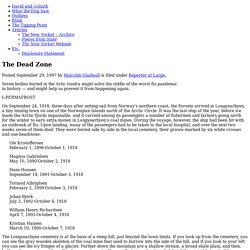
On September 24, 1918, three days after setting sail from Norway’s northern coast, the Forsete arrived in Longyearbyen, a tiny mining town on one of the Norwegian islands north of the Arctic Circle. It was the last ship of the year, before ice made the Arctic fjords impassable, and it carried among its passengers a number of fishermen and farmers going north for the winter to earn extra money in Longyearbyen’s coal mines.
During the voyage, however, the ship had been hit with an outbreak of flu. Spanish Influenza Pandemic and Vaccines — History of Vaccines. Philadelphia Naval Aircraft Factory.
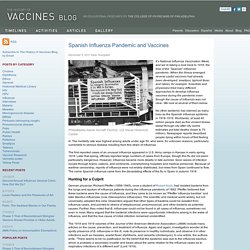
US Naval Historical Center It’s National Influenza Vaccination Week, and we’re taking a look back to 1918, the time of the “Spanish” influenza pandemic. When the illness emerged, several useful vaccines had already been developed: smallpox, typhoid fever, and rabies, for example. INFLUENZA PANDEMIC in AUSTRALIA 1918-19, MELBOURNE STATISTICS: This long envelope was sent from The Town Clerk, St.
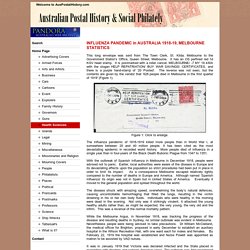
Kilda. Melbourne to the Government Statist’s Office, Queen Street, Melbourne. It has an OS perfined red 1d KGV head stamp. It is postmarked with a roller cancel, MELBOURNE/ -7 MY 19 430A with the slogan HELP REPATRIATION/ BUY WAR SAVINGS/ CERTIFICATES, and there is a purple hand-stamp of ‘20 Posted’. The 1918 flu pandemic - The 1918 influenza pandemic. In the early 21st century anxiety over the danger of Influenza A virus subtypes H5N1 (avian flu) and more recently H1N1 (swine flu) has revived memories of New Zealand's worst disease outbreak, the lethal influenza pandemic that struck between October and December 1918.

In two months New Zealand lost about half as many people to influenza as it had in the whole of the First World War. No event has killed so many New Zealanders in such a short time. In the Norwegian Permafrost, a New Hunt for the Deadly 1918 Flu Virus. LONGYEARBYEN, Norway, Aug. 20— They start digging on Friday morning, the five grave diggers all the way from London.

Actually, much of the time they will be hammering through ice. Here in the islands of Spitsbergen in the high Arctic between mainland Norway and Greenland, the ground three feet down is always frozen. At six feet, they should find the bodies, in the mass grave encased in a tomb of ice. It is the time of the midnight sun. A white fox, its camouflage coat useless now against the bare rock and dark moss, slinks up the steep hill overlooking this small mining town. Over the mass grave a tent with a special air lock has been stretched and inflated. Overview of Influenza Surveillance in the United States. Overview in PDF[178 KB, 5 pages] ( The Epidemiology and Prevention Branch in the Influenza Division at CDC collects, compiles and analyzes information on influenza activity year round in the United States and produces FluView( a weekly influenza surveillance report, and FluView Interactive( which allows for more in-depth exploration of influenza surveillance data.

The U.S. influenza surveillance system is a collaborative effort between CDC and its many partners in state, local, and territorial health departments, public health and clinical laboratories, vital statistics offices, healthcare providers, clinics, and emergency departments. Information in five categories is collected from nine different data sources that allow CDC to: Five Categories of Influenza Surveillance 1. Flublok the answer to ineffective flu vaccines. How Influenza (Flu) Vaccines Are Made. There are three different influenza vaccine production technologies approved by the U.S. Food and Drug Administration (FDA): All commercially available flu vaccines in the United States are made by private sector manufacturers. Different manufacturers use different production technologies, but all flu vaccines meet FDA safety and efficacy requirements. The different vaccines are approved with different indications.
See Influenza Vaccines — United States, 2013–14 Influenza Season( for specific indications. Protection against Influenza A Virus Challenge with M2e-Displaying Filamentous Escherichia coli Phages. Abstract Human influenza viruses are responsible for annual epidemics and occasional pandemics that cause severe illness and mortality in all age groups worldwide. Matrix protein 2 (M2) of influenza A virus is a tetrameric type III membrane protein that functions as a proton-selective channel.
The extracellular domain of M2 (M2e) is conserved in human and avian influenza A viruses and is being pursued as a component for a universal influenza A vaccine. To develop a M2e vaccine that is economical and easy to purify, we genetically fused M2e amino acids 2–16 to the N-terminus of pVIII, the major coat protein of filamentous bacteriophage f88. Epistatic interactions between neuraminidase mutations facilitated the emergence of the oseltamivir-resistant H1N1 influenza viruses.
Oseltamivir is relied upon worldwide as the drug of choice for the treatment of human influenza infection. Surveillance for oseltamivir resistance is routinely performed to ensure the ongoing efficacy of oseltamivir against circulating viruses. Since the emergence of the pandemic 2009 A(H1N1) influenza virus (A(H1N1)pdm09), the proportion of A(H1N1)pdm09 viruses that are oseltamivir resistant (OR) has generally been low.
However, a cluster of OR A(H1N1)pdm09 viruses, encoding the neuraminidase (NA) H275Y oseltamivir resistance mutation, was detected in Australia in 2011 amongst community patients that had not been treated with oseltamivir. Seasonal Influenza (Flu) - How the Flu Virus Can Change. Influenza viruses are constantly changing. They can change in two different ways. One way they change is called “antigenic drift.” These are small changes in the genes of influenza viruses that happen continually over time as the virus replicates. These small genetic changes usually produce viruses that are pretty closely related to one another, which can be illustrated by their location close together on a phylogenetic tree.
Viruses that are closely related to each other usually share the same antigenic properties and an immune system exposed to an similar virus will usually recognize it and respond. The Origin of New Flu Strains. Avian, Swine, and Human Interaction. Evaluation and Capacity Review Tools. 2009 H1N1 Influenza: Monitoring the Nation’s Response. The United States in 1918-1919 :. . : The Great Pandemic : : The United States in 1918-1919 : . Villager’s remains lead to 1918 flu breakthrough. Permafrost Preserves Clues to Deadly 1918 Flu, Alaska Science Forum. April 29, 1998 Permafrost Preserves Clues to Deadly 1918 Flu Article #1386. Influenza Strikes . : The Great Pandemic : : The United States in 1918-1919 : . Throughout history, influenza viruses have mutated and caused pandemics or global epidemics.
Selecting Viruses for the Seasonal Influenza Vaccine. Flu Vaccine Effectiveness: Questions and Answers for Health Professionals. How do we measure how well influenza vaccines work? Two general types of studies are used to determine how well influenza vaccines work: randomized controlled trials and observational studies. These study designs are described below. Randomized controlled trials (RCTs) Infectious Disease Cyber Detectives Keep Governments Accountable. When it comes to tracking emerging infectious diseases, there is a gold mine of online data, but it takes something of a cyber-detective to dig into it. At Boston Children’s Hospital, researchers tap into tens of thousands of sources including social media, news reports and blogs. “We’re constantly looking for keywords about disease and outbreaks and epidemics in 15 different languages, and pulling out those articles,” said Dr.
John Brownstein, chief innovation officer at Boston Children’s Hospital. Antigenic Characterization. Selecting the Viruses in the Seasonal Influenza (Flu) Vaccine. National influenza centres. A multi-valent vaccine approach that elicits broad immunity within an influenza subtype. 05 0979. Reconstruction of the 1918 Influenza Virus: Unexpected Rewards from the Past. 20020513001in. The American Influenza Epidemic of 1918: A Digital Encyclopedia. The Influenza Epidemic of 1918. Otago030815. The Influenza Epidemic of 1918 (Spanish Flu) - Newspaper and Current Periodical Reading Room (Serial and Government Publications Division, Library of Congress) Image 1 of Letter from Alexander Graham Bell to Mabel Hubbard Bell, December 8, 1918. Racial Disparities in Exposure, Susceptibility, and Access to Health Care in the US H1N1 Influenza Pandemic.
The Role of Host Genetics in Susceptibility to Influenza: A Systematic Review. The Causes of Racial and Ethnic Differences in Influenza Vaccination Rates among Elderly Medicare Beneficiaries. 1917 - 1918: Establishment of Camp A.A. Humphreys. Volunteer nurse letter.